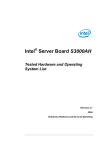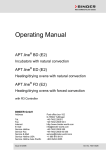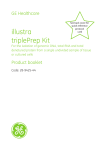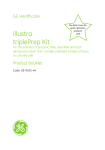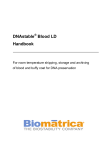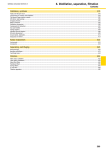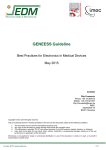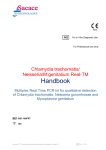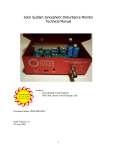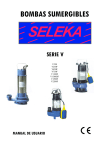Download DNAgard Tissue
Transcript
DNAgard® Tissues & Cells Handbook Preserve DNA in biological samples at room temperature For room temperature storage and shipment of DNA in tissues & cells. Item No. 9101 / Rev. 08/2011 Contents Kit Components Storage Product Use Limitations Safety Information Protocols for DNAgard Tissue - Liquid Format 3 3 3 3 4 SAMPLE STORAGE 4 SAMPLE RECOVERY 6 Appendices 10 Appendix A: DNA extraction from tissue samples stored in liquid DNAgard Tissue – modified protocol for QIAamp DNA Mini Kit. 10 Appendix B: DNA extraction from mammalian tissue culture cells stored in liquid DNAgard Tissue – modified protocol for GE Illustra Tissue and Cells Genomic Prep Mini Spin Kit. Technical Assistance Page 2 of 13 / Item No. 9101 / Rev. 08/2011 11 13 DNAgard® Tissue is designed for room temperature storage and shipment of DNA in biological tissues, such as mammalian cells and organ tissues. DNA in complex samples is protected by the unique stabilization properties of DNAgard Tissue. Samples are kept at room temperature, removing the need for frozen storage or immediate processing. DNAgard Tissue is easy to use - samples are applied into the DNAgard Tissue solution, mixed, and stored. Samples can be stored in liquid DNAgard Tissue for at least 6 months at room temperature. Samples stored in liquid DNAgard Tissue are ready for immediate processing for DNA recovery via column extraction (following manufacturer’s instructions) or using standard lab procedures involving digestion and organic extraction. Purified DNA can be used directly in downstream applications. Kit Components DNAgard Tissue (50 ml or 100 ml bottle) Protocol Storage DNAgard Tissue must be stored at room temperature. Use within 6 months of purchase date for optimal product performance. DNAgard Tissue stabilizes genomic DNA in cultured cells and animal tissue samples for at least 6 months at room temperature in a liquid storage format. Product Use Limitations The DNAgard Tissue test kit is for research use only. No claim or representation is intended to provide information for the diagnosis, prevention, or treatment of disease. Safety Information DNAgard Tissue contains chaotropic salt and other chemicals that are harmful if swallowed and irritating to eyes and skin (R22-R36/38, S13/26/36/46). Keep away from food and drink. Wear suitable protective clothing and gloves. In case of contact with eyes, rinse immediately with plenty of water and seek medical advice. If swallowed, seek medical advice immediately. CAUTION: DNAgard Tissue contains chemicals that form highly reactive compounds when combined with bleach. DO NOT add bleach or acidic solutions directly to the sample-preparation waste. Page 3 of 13 / Item No. 9101 / Rev. 08/2011 Protocols for DNAgard Tissue - Liquid Format SAMPLE STORAGE Storage of Tissue Samples in DNAgard Tissue – Liquid storage 1. Prepare tissue samples by dissection. For optimal DNA protection, store tissue fragments less than 75 mg. Small tissue fragments, thinly sliced (at least one edge of the tissue fragment be 5mm or less in length), ensures that DNAgard Tissue permeates rapidly the entire tissue sample. To maintain the integrity of the DNA, tissue fragments should be kept cold during dissection and transferred to DNAgard Tissue as soon as possible. 2. Submerge tissue fragment in 500 µl (at least 100 µl per 10 mg of tissue are required) DNAgard Tissue solution for shipment or storage. If sample is to be shipped, it is important to select a tube size that ensures that the tissue remains submerged during handling. We recommend the use of screw-cap tubes to prevent sample leakage during transport. For general storage, use 2 ml screw-cap tubes. 3. Store samples at room temperature and protected from light for 6 months. Page 4 of 13 / Item No. 9101 / Rev. 08/2011 Storage of Tissue Culture Cells in DNAgard Tissue– Liquid storage Genomic DNA from tissue culture cells is released into the DNAgard Tissue solution during storage and is stabilized for two months. DNA extraction methods using phenol-chloroform are not compatible with DNAgard Tissue solution. Columnbased DNA isolation methods must be used for cells stored in DNAgard Tissue. 1. Aliquot cells for shipment or storage. DNAgard Tissue has been shown to protect genomic DNA in sample concentrations ranging from 2x103 to 106 cells per 100 µl DNAgard Tissue. We recommend the use of screw-cap tubes to prevent sample leakage during transport. When choosing the number of cells to store, consider the desired DNA yield and the specifications of the DNA isolation procedure used to recover the genomic DNA. Refer to the manufacturer’s specifications in the DNA isolation protocol for product limitations and expected yields (in general, approximately 200 – 600 ng of nucleic acid can be recovered from 10 5 cultured cells containing a normal set of chromosomes). 2. Pellet cells at 3500xg for 1-2 minutes in a micro-centrifuge (volumes exceeding 1.5 ml may require longer spin times). Remove supernatant. 3. Add a minimum of 100 µl of DNAgard Tissue solution for every 106 cells (preferably, use screw cap tubes to avoid spillage). Pulse-vortex samples to re-suspend pellet. If the cell suspension in DNAgard Tissue is too viscous to pipette, then add more DNAgard Tissue solution. Avoid adding excessive amounts of DNAgard Tissue, as this will increase the volumes of reagents required for DNA recovery. 4. Store samples at room temperature and protected from light for 6 months. Page 5 of 13 / Item No. 9101 / Rev. 08/2011 SAMPLE RECOVERY General Note: This product is designed for optimal DNA recovery using commercially available DNA isolation column technologies or (for tissue samples) standard, organic extraction methods. Sample recovery from tissue samples stored in DNAgard Tissue – liquid storage The genomic DNA of samples stored in liquid DNAgard Tissue is stable for 6 months at room temperature. 1. Process samples for DNA recovery via commercially available column purification technologies (Sections 1a, 1b & 1c; and Appendix A) or via standard laboratory procedures involving tissue lyses and organic extraction (1d). For ease of use, we recommend removing the DNAgard Tissue solution from the tissue fragment prior to DNA isolation. However, if DNA yield is critical, optimal DNA recovery can be achieved by isolating genomic DNA from the entire DNAgard Tissue sample (tissue fragment plus DNAgard Tissue solution – see sections 1a and 1 b below and Appendix A). Note on tissue disruption: DNA isolation via commercially available column technologies can often be facilitated by disruption of the tissue sample, thereby reducing the time required to fully lyse the tissue and release genomic DNA. We recommend the use of a pestle. Consult the DNA isolation manufacturer’s instructions. a. Removal of DNAgard Tissue solution for DNA purification using column technologies. In cases where maximal DNA yield is not critical or a reduction in reagent volumes is desired, DNAgard Tissue solution can be pipetted off prior to DNA extraction using column purification kits. Take care to avoid pipetting off tissue fragments. Process the tissue fragment for DNA isolation according to the kit manufacturer’s instructions. b. Maximal DNA recovery of genomic DNA. For column purification protocols allowing DNA isolation from tissue samples re-suspended in buffer, no additional processing of DNAgard Tissue samples is needed. Follow manufacturer’s instructions for DNA isolation, adhering to buffer-to-sample ratio specifications. Page 6 of 13 / Item No. 9101 / Rev. 08/2011 Note: Check with the manufacturer’s instructions for DNA isolation to determine reagent volumes needed to process the DNAgard Tissue sample. It is often necessary to transfer the sample, after tissue lysis, to a larger capacity tube (i.e. > 2 ml) or to divide the sample into multiple tubes. We have developed an alternate protocol for the QIAamp DNA Mini Kit (Qiagen) to minimize reagent volumes needed for DNA isolation from tissues stored in liquid DNAgard Tissue. See Appendix A. c. Maximal DNA recovery of genomic DNA – modified protocol for column purification kits that initiate from a tissue sample free of liquid. Simply add the kit’s initial lyses buffer in a 1:1 ratio with the DNAgard Tissue volume. Scale all other reagents as necessary based on this initial volume (proceed as if the resultant mixture was entirely kit lysis buffer) and process according to the kit specifications. (We have verified this modified protocol with the following DNA isolation kits: GE illustra tissue and cells genomicPrep Mini Spin Kit, Invitrogen PureLink Genomic DNA mini Kit, MO BIO UltraClean Tissue & Cells DNA Isolation Kit and QIAGEN QIAamp DNA Mini Kit). An example of a modified protocol for DNA extraction from tissue stored in liquid DNAgard Tissue using the QIAGEN QIAamp DNA Mini Kit is provided in Appendix A. This protocol minimizes the reagent volumes required for DNA isolation. d. DNA isolation involving organic extraction. Tissues stored in DNAgard Tissue can be processed for DNA isolation using standard lab protocols involving tissue lyses and organic extraction. Simply pipette off the DNAgard Tissue solution, being careful to not remove the tissue sample. Add lyses buffers and enzymes according to protocol. Page 7 of 13 / Item No. 9101 / Rev. 08/2011 Sample recovery from tissue culture cells stored in DNAgard Tissue – liquid storage The genomic DNA of samples stored in liquid DNAgard Tissue is stable for at least 6 months at room temperature. Samples can be processed for DNA recovery directly via commercially available column purification technologies – no additional processing of DNAgard Tissue samples is needed. DNAgard Tissue solution should not be removed prior to sample processing; add lyses buffers and enzymes provided in your DNA isolation kit directly to the DNAgard Tissue sample. Follow manufacturer’s instructions for DNA isolation, adhering to buffer-to-sample ratio specifications. Do not use organic extraction methods for DNA isolation (i.e. phenolchloroform extraction). If using a DNA isolation kit that specifies a protocol for cells re-suspended in buffer or media, we recommend following the instructions in section 1 below. (e.g., QIAGEN QIAamp DNA Mini Kit; Invitrogen PureLink Genomic DNA Mini Kit). If using a DNA isolation kit that does not specify a protocol for cells re-suspended in buffer (if there is only a protocol initiating from a cell pellet) follow the instructions in section 2 below. (e.g. GE Illustra, MO BIO UltraClean). 1. Column purification protocols allowing DNA isolation from cells resuspended in buffer or media: In this case, DNAgard Tissue can be treated as if it were any re-suspension buffer or media. Follow manufacturer’s instructions for DNA isolation, adhering to reagent ratio specifications. Note: Check with the manufacturer’s instructions for DNA isolation to determine reagent volumes needed to process the DNAgard Tissue sample. Depending on the initial volume of DNAgard Tissue, it is sometimes necessary to transfer the sample to a larger capacity tube (i.e. > 2 ml) or to divide the sample into multiple tubes. 2. Using column purification protocols that do not specify DNA isolation from cells re-suspended in buffer or media: Do not pellet the DNAgard Tissue-cell suspension (genomic DNA from cells is released into the DNAgard Tissue solution during storage). Simply add the kit’s initial lysis buffer in a 1:1 ratio with the DNAgard Tissue volume. Scale all other reagents as necessary based on this initial volume (proceed as if the resultant mixture was entirely kit lyses buffer) and process according to the specifications described in the kit. (We have verified this modified protocol with the following DNA isolation kits: GE Illustra Tissue Page 8 of 13 / Item No. 9101 / Rev. 08/2011 and Cells Genomic Prep Mini Spin Kit and MO BIO UltraClean Tissue and Cells DNA Isolation Kit). An example of a modified protocol for DNA extraction from mammalian tissue culture cells stored in liquid DNAgard Tissue using the GE illustra tissue and cells genomicPrep Mini Spin Kit is provided in Appendix B. Note: 2 ml tubes should be of sufficient volume in most DNA isolation protocols. However, check with the manufacturer’s instructions to insure that this is the case. If not, divide the DNAgard Tissue sample into multiple tubes prior to processing. Page 9 of 13 / Item No. 9101 / Rev. 08/2011 Appendices Appendix A: DNA extraction from tissue samples stored in liquid DNAgard Tissue – modified protocol for QIAamp DNA Mini Kit. The following protocol has been proven compatible with DNAgard Tissue for maximum genomic DNA isolation. This protocol minimizes the reagent volumes required for DNA extraction. Addition of all reagents (prior to loading on the QIAamp column) is less than 1800 µl, so samples can be processed in 2 ml microfuge tubes. The following protocol is for DNA recovery from a tissue sample stored in 500 µl DNAgard Tissue: 1. Recommended: Tissue disruption. Tissue lysis can be facilitated by disruption with a sterile pestle. 2. Add 400 µl Buffer ATL. 3. Add 40 µl proteinase K, mix by vortexing and incubate at 56°C until the tissue is completely lysed. Sample lyses can be facilitated by using a shaking incubator and occasional vortexing. 4. Optional: Add 18 µl RNase A (100 mg/ml), mix and incubate for 2 min. at room temperature. 5. Add 400 µl Buffer AL and mix by pulse-vortexing for 15 sec. Incubate at 70°C for 10 min. 6. Add 400 µl ethanol (100%) and mix by pulse-vortexing for 15 sec. 7. (The remaining steps are the same as those indicated in the manual for DNA purification from tissues). Apply up to 700 µl of the sample to the QIAamp Mini Spin column (in a 2 ml collection tube). Centrifuge at 6000 x g (8000 rpm) for 1 min. Transfer the column to a clean collection tube and discard the tube containing the filtrate (Qiagen recommends processing a maximum of 25 mg of tissue (10 mg for spleen) per column). 8. Repeat step 6 (as needed) to load entire sample on column. 9. Add 500 µl Buffer AW1 to the column. Centrifuge at 6000 x g (8000 rpm) for 1 min. Transfer the column to a clean collection tube and discard the tube containing the filtrate. 10. Add 500 µl Buffer AW2 to the column. Centrifuge at maximum speed (20,000 x g; 14,000 rpm) for 3 min. 11. Recommended: Transfer the column to a clean collection tube and discard the tube containing the filtrate. Centrifuge at maximum speed for 1 min. 12. Transfer the column to a clean 1.5 ml microfuge tube. Add 200 µl Buffer AE or water and incubate at room temperature for 1 min. Centrifuge at 6000 xg (8000 rpm) for 1 min. Page 10 of 13 / Item No. 9101 / Rev. 08/2011 Appendix B: DNA extraction from mammalian tissue culture cells stored in liquid DNAgard Tissue – modified protocol for GE Illustra Tissue and Cells Genomic Prep Mini Spin Kit. 1. Determine the amount of DNAgard Tissue that was aliquoted to store the cells. Add the same volume of Lysis buffer type 1 to the sample containing DNAgard Tissue. For example, a sample of cells in 100ul DNAgard Tissue should receive 100ul of Lysis buffer type 1. Mix well by pipetting up and down or vortexing for 15 seconds. 2. Add 10ul proteinase K (20mg/ml) to the samples. Mix by vortexing for 15 seconds. 3. Incubate samples at 56°C for 15 minutes. Transfer samples to 70°C and incubate for 2 minutes. During this step, preheat an aliquot (200ul per sample) of Elution buffer type 5 at 70°C. The buffer will be used for elution during the last step. 4. Add 5ul RNase A (20mg/ml). Incubate at room temperature for 15 minutes. 5. Add 1000ul Lysis buffer type 4. Incubate at room temperature for 10 minutes. 6. Apply a portion of the sample to column. The capacity of the column is 720ul. Spin sample at 11,000 x g for 1 minute. Discard flowthrough and apply the rest of the sample to the column. Spin again at 11,000 x g for 1 minute. 7. Wash by adding 500ul Lysis buffer type 4 to the column. Spin at 11,000 x g for 1 minute. 8. Add 500ul Wash buffer type 6. Spin at 11,000 x g for 3 minutes. 9. Before proceeding, make sure that the column is completely dry. Perform an additional spin if necessary. 10. Transfer column to a fresh sample collection tube. Add 200ul of preheated Elution buffer type 5 (from step 3) to the column. Incubate for 1 minute at room temperature. Spin at 11,000 x g for 1 minute to elute DNA. Page 11 of 13 / Item No. 9101 / Rev. 08/2011 Notes Page 12 of 13 / Item No. 9101 / Rev. 08/2011 Technical Assistance Biomatrica, Inc. takes pride in providing efficient quality technical support. Biomatrica’s Technical Service Department is staffed by experienced scientists with extensive practical and theoretical expertise in molecular biology and the use of Biomatrica’s biostability and storage products. Please contact Biomatrica directly with any questions regarding DNAstable technology, product use, or general matters. Technical Service Department: Phone: USA (866) DRY-MTRX or (866) 379-6879 Web: www.biomatrica.com Email: [email protected] 5627 Oberlin Drive, Suite 120 San Diego, CA 92121













